This article was published in Volare magazine in
Italy. |
| |
Frati's New Airplanes
by Fabrizio S. Bovi
If you think that 84-year-old Stelio Frati, the world-renown
airplane designer, can rest on laurels, you are wrong. He, along
with some other designers of his generation is very special people.
Designing, creating is their source of energy. Mr. Frati is
working from home now, and two new different airplanes are coming
to life on his drawing board in his apartment in downtown Milan.
They are a transport twin turboprop (F.2500) and a small two-seat
jet (F.1000).
As usual, Mr. Frati preferred understatement. He pointed
out that his new planes are "The evolution of ideas I already
had in the past." But he fails to point out that they were
such leading-edge ideas that much time was needed to push them
forward. It is on the other hand true that the F.2500 and F.1000
show the same sleekness and grace as all his previous creations.
|
|
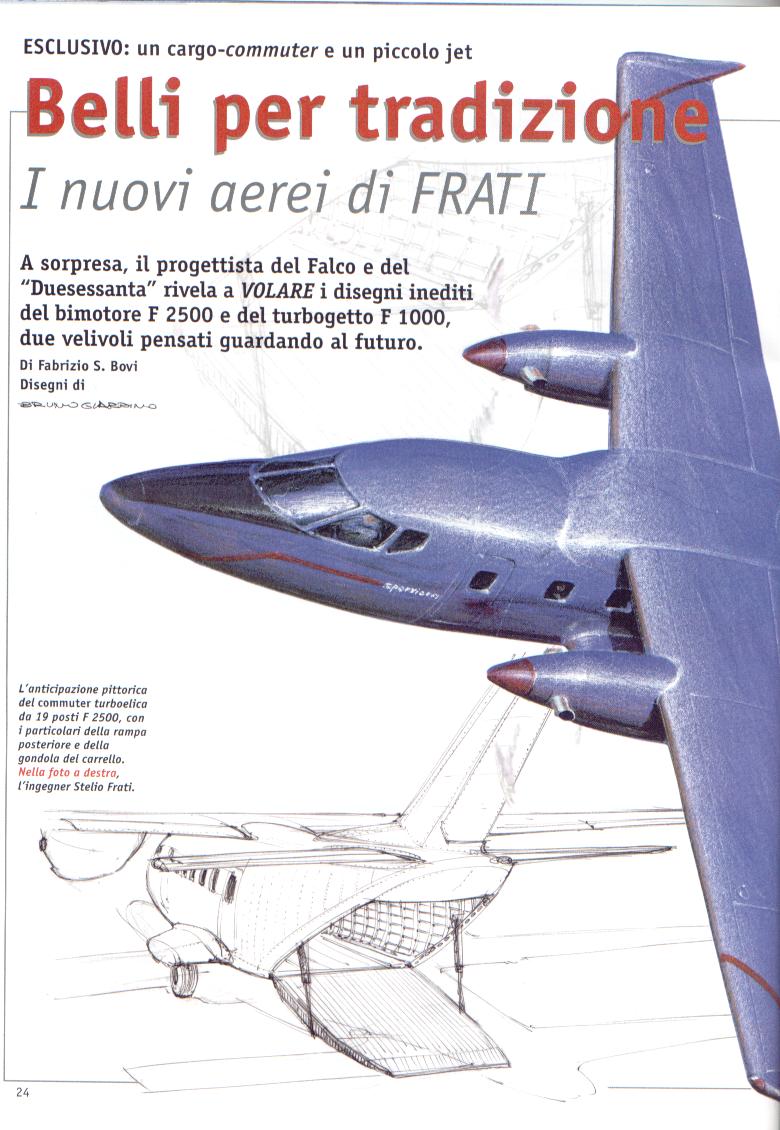
| |
We gave the airplane three-views to Bruno Giardino, who works
with the car designers Giugiaro and Pininfarina, and asked him
to give us artist's renderings. You can see the results in these
pages.
"The F.1000 twin-turboprop derives from the 19-seat F.3000
twin jet developed some 15 years ago" Mr. Frati explained.
"The F.3000 had to be powered by two 3,000-lb thrust Garrett
TPE 731 engines. It was meant to compete with the Dornier 328.
The cabin was the roomiest in its class, with seats arranged
on three rows, overhead bins and toilets. Unluckily, success
did not smile on this aircraft: SIAI Marchetti scrapped its production
from its programs, and General Avia, another company in the loop,
which had already started manufacturing the first engineering
mock-up, also gave up."
|
|
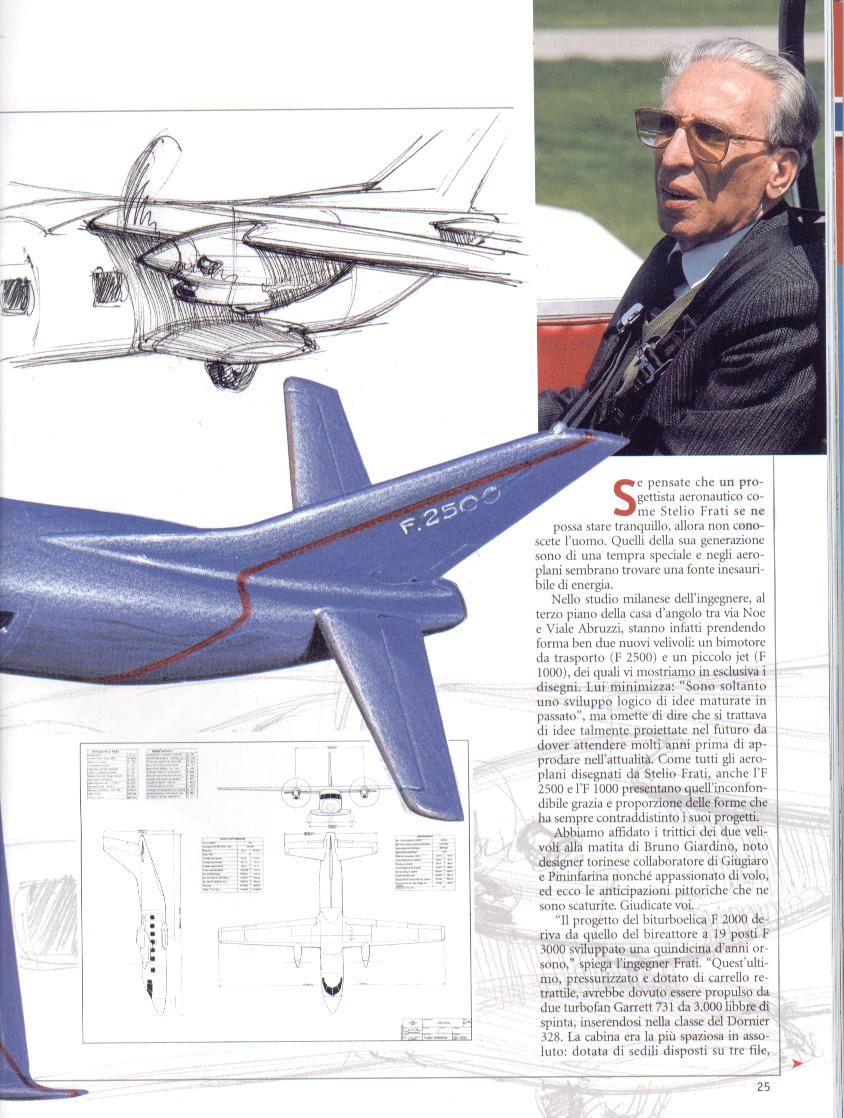
| |
The F.2500 commuter maintains the general architecture of
the F.3000, but it has been modified to transport freight from
and to small airports. Those whose runways are shorter than
1,200 meters, are becoming more and more important, due to the
increasing congestion at the larger ones. And, in fact, the
US government's SATS project calls for the building of 5,400
new facilities within 2010.
Frati told us about his new airplane: "In order to meet
the new demands, I have conceived a twin turboprop in the 1,200
shp class. The installed power and the not supercritical airfoil
(series NACA 63) give the aircraft good STOL characteristics
and a satisfactory cruise speed without increasing the moment
coefficients too much".
|
|
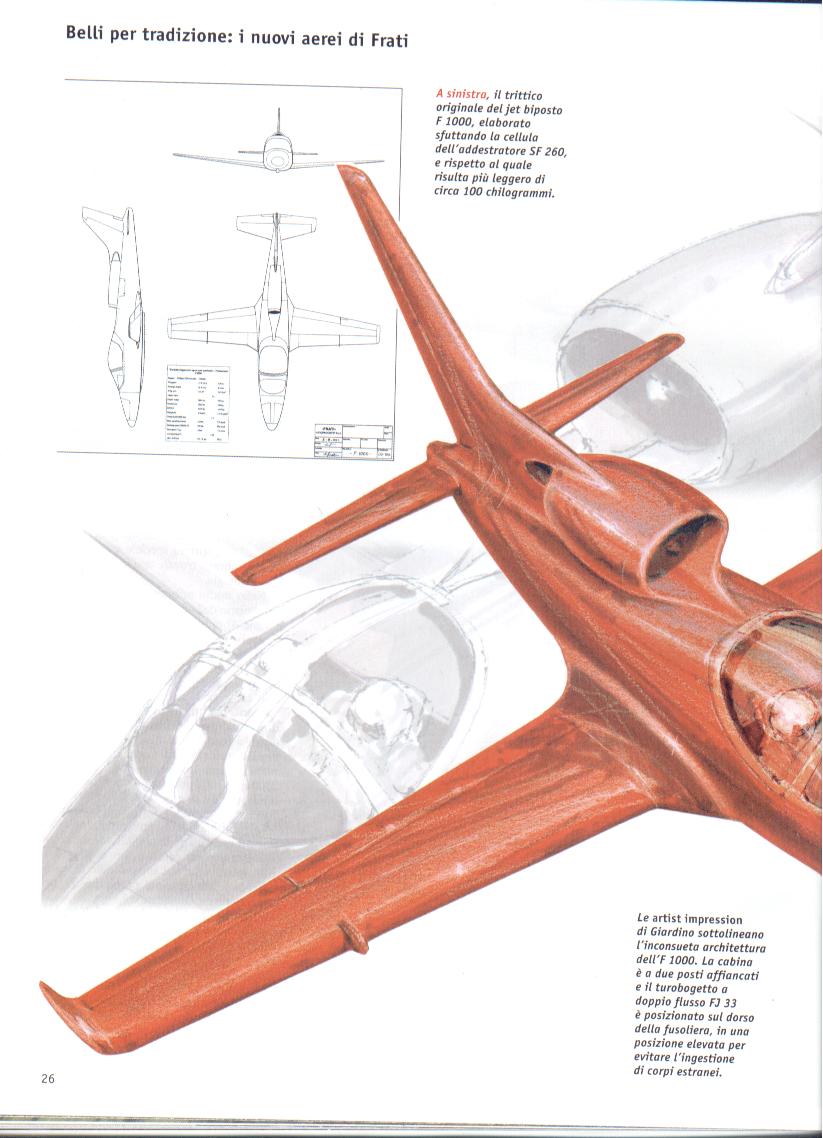
| |
The airplane will be able to operate from grass strips, and
is fitted with a large rear ramp equipped with an electrically
operated winch. The winch will be used to load as many as nine
different types of containers according to the IATA standard
(the size of model 17 is 148x148x107 cm), for a total payload
of up to 3,200 kg."
Mr. Frati also underscored that the cargo hold volume is 20
cu.m while the floor area is 11.70 sq.m. The large access door
and the need to have a hold entirely free from obstacles, resulted
in the installation of cable-operated controls for the rudder
and tail plane. They run on the cabin ceiling and have large
pulleys that provide for the rigid transmission.
|
|
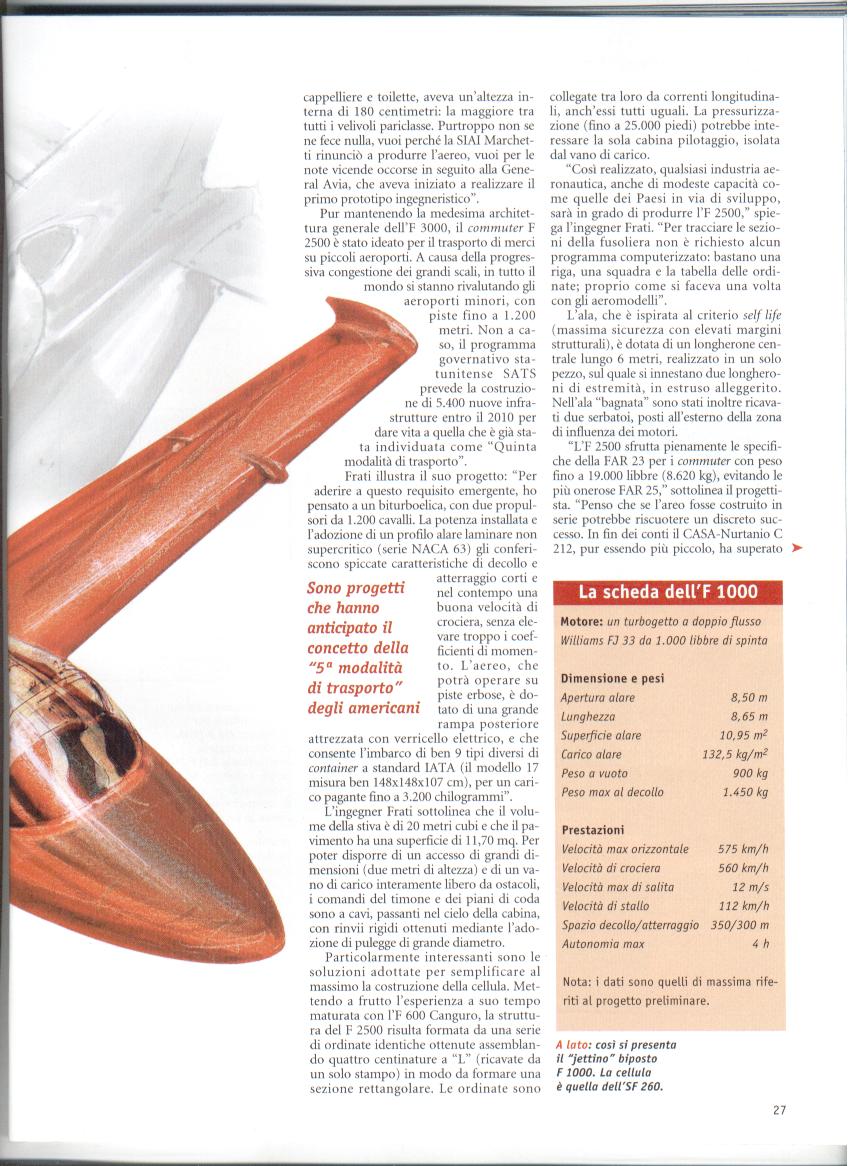
| |
The solutions adopted to simplify the airframe construction
as much as possible are particularly interesting. Based on the
experience gained in the past with the F.600 Canguro, the structure
of the F.2500 is square and consists of a number of identical
frames resulting from the assembling of four L-shaped members.
The pressurization (up to 25,000 feet) could be limited to the
cockpit, which is isolated from the cargo hold.
"These features make the F.2500 suitable for manufacture
also in the countries where the experience in aeronautical constructions
is limited, like the developing ones", Mr. Frati explained.
"You do not need a computer program to draw the fuselage
sections; a ruler, a triangle and the applicable frame tables
are enough, like when we built models in the past."
The wing, designed with the safe life criterion in
mind, that is for maximum safety and high structural margins,
has a six-meter, single-piece center spar to which there connect
two end spars from a lightened extrusion. The wet wing contains
two tanks located in the area outboard of the engine-affected
area.
|
|
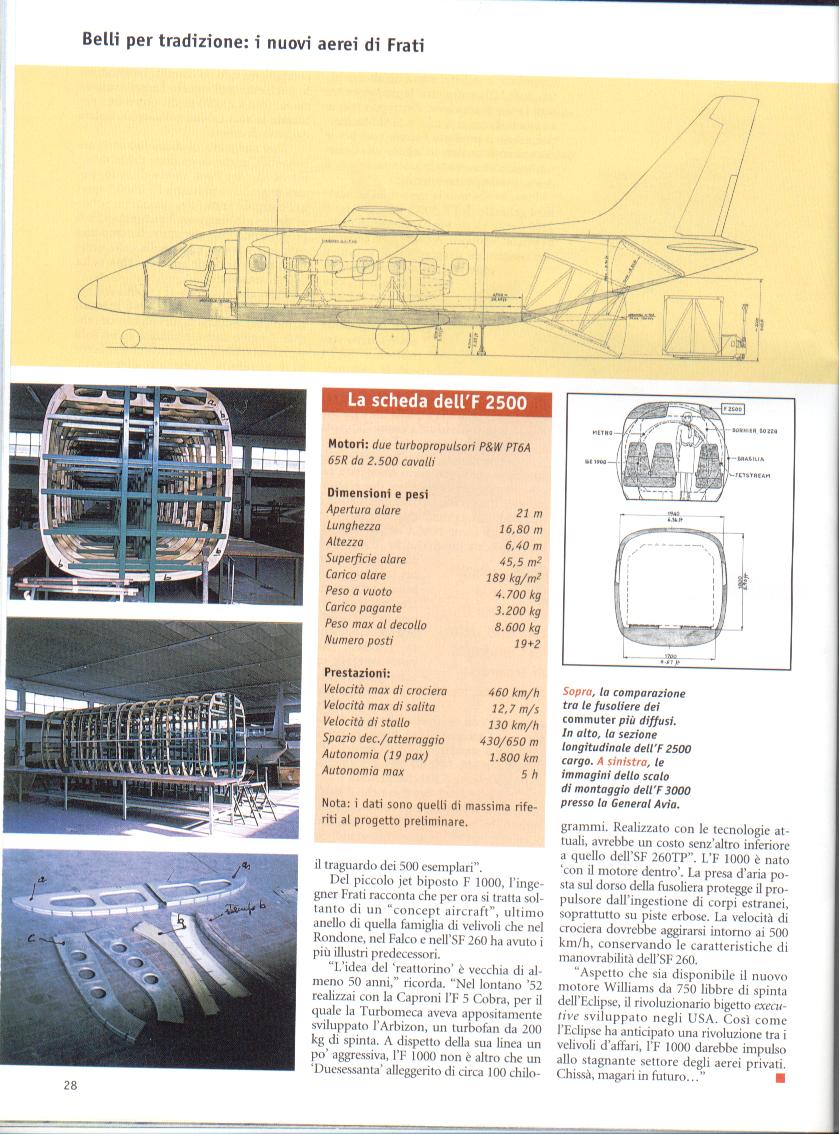
| |
"The F.2500 meets FAR 23 requirements applicable to commuters
with weight up to 19,000 lb (8,620 kg), and is very close to
the limits. It was in fact decided to avoid falling in the category
covered by the more burdensome FAR 25", noted Stelio Frati.
And added: "I do believe that this aircraft, if it is eventually
built, might be a successful one. In the end, as many as 500
CASA Nurtanio C.212s have been sold. And the Aviocar is smaller
than the F.2500".
Mr. Frati also told VOLARE that the small F.1000 two-seat
jet is only a concept aircraft so far. It is a scion of the
family that includes the F.4/F.7 Rondone, the F.8 Falco and the
SF.260.
"The idea of the small jet is over 50 years old."
noted Frati. "Back in 1952, I designed the F.5 Cobra for
Caproni. Turboméca developed the Arbizon, a 200-kg thrust
turbofan engine specifically for it. Despite its aggressive
appearance, the F.1000 is only a lighter (nearly 100 kg) SF 260.
If it is built by exploiting the currently available technologies,
it will cost definitely less than the SF.260 TP". The F.1000
has been conceived around its engine. The dorsal air intake
protects the engine from foreign object ingestion, especially
on grass strips. Cruise speed should be about 500 km/h, the
maneuverability characteristics should be similar to those of
the SF.260.
"I look forward to the availability of the 750-lb thrust
Williams engine powering the Eclipse prototype, the innovative
twin-jet developed in the USA. The Eclipse has revolutionized
the biz-jet sector. The F.1000 could do the same in the now
fairly depressed sector of the private airplanes. I hope so."
|
|
|
![]()